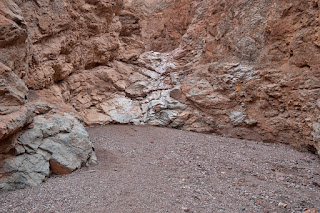Thursday was our last day in Death Valley National Park. We had breakfast at the hotel and then headed to Badwater Basin, the lowest place in North America.
The trail here led out towards the salt flats.
The low elevation and strange footing made for a very surreal hike.
It was just under a mile to get out to the salt flats, the final destination for water in the Death Valley drainage.
As the water evaporates, the minerals dissolved by the rainwater are left behind forming salt crystals that take unusual forms.
It kind of looked like snow, but was dry and hard. The salt cake has cracked into all sorts of shapes.
We walked around the salt flats getting pictures for a while and then headed back. I stopped to get a photo of Badwater Pool, a spring fed pool of fossil water.
From the parking area, Telescope Peak was reflecting in the pool.
What a cool place.
From here, we drove back a short ways and turned on the gravel road for Natural Bridge. A short trail led into the red-rock canyon.
In just over a quarter-mile, we came to the Natural Bridge.
It's about 35 feet above the canyon floor and 35 feet thick.
Just past the bridge was a tall, steep dry waterfall.
The trail then turned to the right and ended at a small dryfall. Most people turned around here, but it was pretty easy to climb.
There was another little dryfall with greenish rocks that was also easy to climb.
The trail really ended at a 15 or so foot dryfall that would be very difficult to climb without gear.
We turned around at this point and started making our way back.
A short hike, only about 3/4 of a mile, but a really cool canyon.
Back on the main road, we continued past Artist's Drive and turned on the short Desolation Canyon Road to the trailhead. The trail led into the colorful canyon.
As soon as the trail narrowed, we started to see some of the colorful rocks walls, similar to Artist's Palette.
Parts of the trail were very narrow.
In about a mile, there was a dry waterfall to climb up, but it wasn't difficult at all.
I was surprised there weren't nearly as many people on this trail as others we had been on. It was really beautiful and not too hard.
There was a second small dry waterfall to climb up but it was easier than the first.
The canyon opened up a bit more and there signs of rockslides.
The rainbow-colored rocks were really amazing.
The green was not from copper, but from chlorite and nontronite.
There were a few side canyons to explore but most didn't go very far.
Eventually, the trail got steeper and led up to a fantastic view over the canyon.
We could see Artist's Drive in the other direction.
We took a break up here and had a snack enjoying the view.
We explored a couple more side canyons on the hike back.
Even the fallen boulders were colorful.
There was one side canyon about half way back that went pretty far in to an impassable rock wall.
We finished up the hike not long before sunset.
Back to the main road, the desert was beautiful in the fading light.
It would be our last sunset in Death Valley and we wanted to make it count, so headed to Harmony Borax Works.
Borax was one of the only materials that had been profitably extracted from Death Valley. Harmony Borax Works was one such operation that that operated during the late 19th century.
As the sun went down, the sun lit up in the most beautiful colors.
Death Valley really has the best sunrises and sunsets.
We stayed here enjoying the colors until darkness.
Then we headed back to the hotel.
We had dinner at the hotel again and I took a very short dip in the pool. The water is spring-fed so its warm year-round, but the air temperature had dropped since the sunset. I only stayed in for a few minutes then tried to warm up at the fire. Then we started packing up to check out in the morning.










































No comments:
Post a Comment